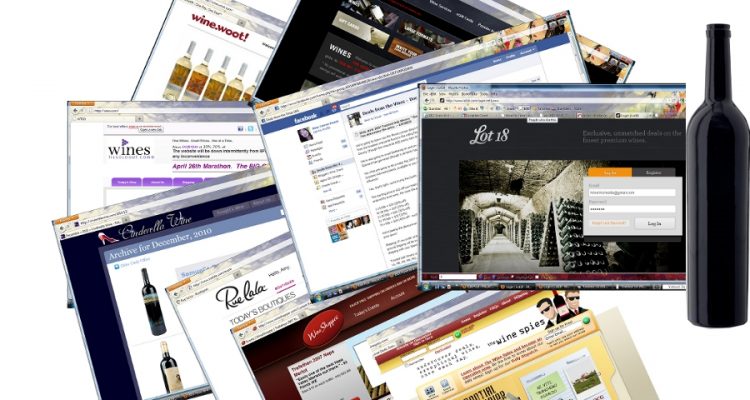Everybody loves a good bargain, but few wine connoisseurs would admit to shopping on QVC or Ebay for their wines. Flash sites offer quick deals for the savvy wine consumer, but are they just another flash in the pan?
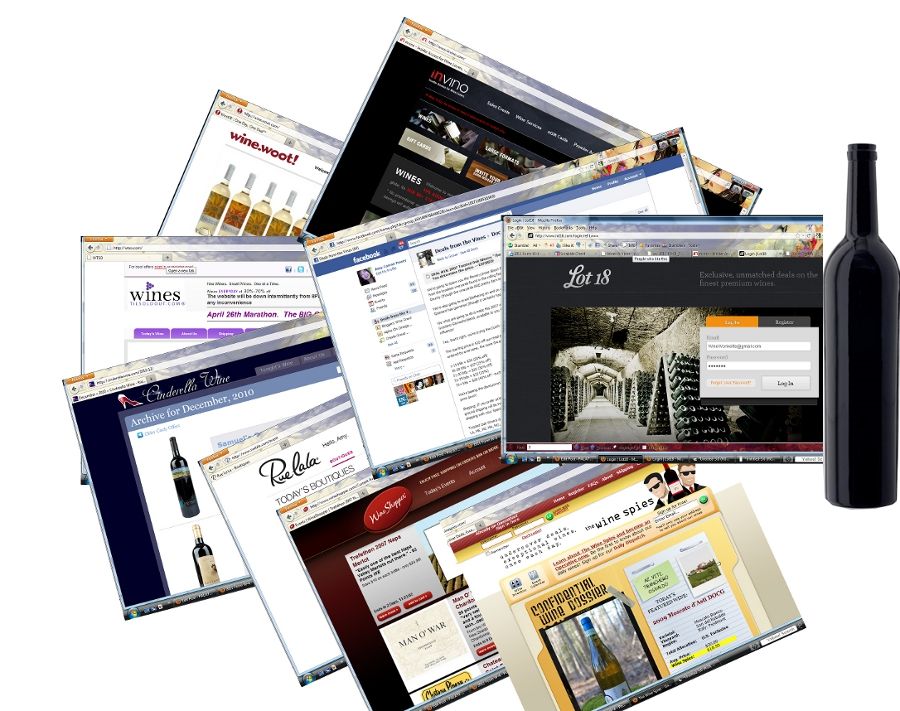
What are Flash sites? Typically, they are sites that offer deep discounts on products, in this case wine, for a very limited duration—anywhere from 24 to 72 hours, or until sold out.
Some sites are specifically dedicated to wine, while others have branched out to an occasional wine sale while still concentrating primarily on clothing, jewelry and goods for the home. There is no question that these sites provide a great bargain to the consumer, but do they provide benefits and challenges to the winery as well?
In the February 2011 issue, the industry magazine Wines & Vines announced a new feature to monitor and evaluate the more prominent Flash sale sites. The publication identified six of the more prominent, including Gary Vaynerchuk’s Cinderella Wine, wine.woot!, Wines ‘Til Sold Out, The Wine Spies, Wine Shopper, and Lot 18, and tracked some of the wines sold on the sites and the prices offered. (The full digital version of the report is available only to subscribers.) Unfortunately they had trouble getting much input from wineries, citing “dozens of phone calls to normally reliable contacts” that garnered “reluctance to talk about” the sites “either on or off the record.”
I talked to a number of wineries in California—the state Wines & Vines reports as the source of most Flash site offerings—to get the winery perspective. I was particularly interested in their experience and preference for particular Flash sites; lessons learned and thoughts on the future of the Flash sales channel. I contacted wineries with which I not only had an existing relationship, but those whose wines I had recently purchased. Of the eight wineries contacted; three agreed to go “on the record,” three wished to remain anonymous, one did not respond to my request and another refused to provide any specific information, saying:
As far as the experience we had with Rue La La, unfortunately our policy is that all sales outside of direct and wholesale are to remain confidential … my apologies that we can’t provide any information for you!
Wine from those wineries commenting (both on and off the record) were featured on wine.woot!, The Wine Spies, Lot 18, invino, Deals from the Vines, and Rue La La. I did not include Cinderella Wine or Wines ‘Til Sold Out because neither sells to Texas residents due to Texas’ ban on out-of-state retail direct sales to consumers.
There was a general consensus among all the wineries responding that Flash sites offer wineries an additional sales channel that can provide a needed infusion of cash.
“The obvious benefit is that there is an opportunity to move more inventory over a short period than one might through ordinary channels,” says John M. Kelly, Owner & Winemaker at Westwood Winery in Sonoma. “These days most wineries are focused on cash flow over profits, and the deal-a-day sellers are taking advantage of this. It is a supply-driven business model.”
While Kelly won’t “name names,” he finds most of the “deal-a-day” sites, as he calls them, pretty much the same. He notes the major potential drawback is brand damage. “It hurts when heavily-discounted prices show up on Internet aggregator sites,” says Kelly. “There is potentially a persistence to that information that can outlive the deal—and this can damage existing relationships with retailers and wholesalers, and especially direct consumers.”
One Napa Valley winery is less positive on the entire Flash sales experience. The winery sales manager, who prefers to remain anonymous, says, “Like many things in life, so-called ‘Flash’ sites come in many flavors, some more palatable than others.” The manager goes on to say:
There is a common thread to most, but not all, the Flash sites’ business models: passing the deepest possible discount to the consumer by putting sheer pressure on the wine producer to sell as close to cost as they feel they can get. The most aggressive sites are sometimes unconcerned about how good a wine is because to them it is a mere financial transaction. It is wine but it could be anything and, as a matter of fact, some people behind these sites are just replicating their model with other products.
For the wine producer, the Napa Valley sales manager says, it is also a mere financial transaction, although for very different reasons.
Every winery needs cash flow every year to pay their bills. Winemaking is not a business that can be put on hold while the economy gets better. While Flash sites would have their place in a “normal” market situation, their ubiquity is exacerbated by the current economic climate in which some wineries have no other alternative to generate cash-flow.
While this is inherently negative, it cannot be denied that it may be beneficial in certain cases. But at the end of the day, it is not interesting for a reputable producer to sell their wine at the price paid by Flash sites and, in some instances, to the clientele they cater to.
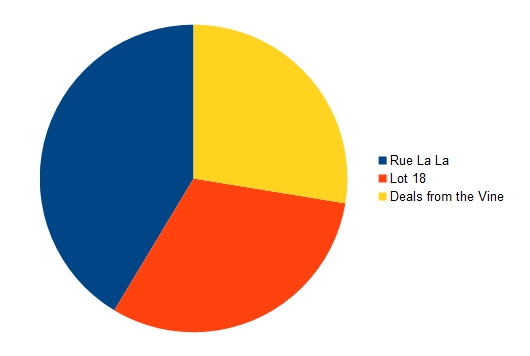
Over the past 18 months, I have purchased about 65 bottles of wine through Flash sites. While primarily through Rue La La and Lot 18, wines also came from Deals From the Vines. At the time of my purchase, The Wines Spies did not ship to Texas, but the winemaker allowed me to purchase and ship directly through the winery at The Wine Spies’ advertised price.
Deals from the Vines provided me the deepest discounts, which honors a promise made to members in their guarantee.
Deals from the Vine
A Facebook closed group “experiment” started by VinTank, Deals from the Vine quickly grew to 1,675 members. Paul Mabray and the folks at VinTank distinguish themselves from the other Flash sites in several ways, first and foremost in creating a community where the buyers and winery interact.
Says Mabray,
Deals from the Vine is an experiment in social commerce. To succeed as such, it requires interaction between members and participating wineries. Deals from the Vines serves both parties: 1) it allows wineries to introduce members to their brand and build relationships; and 2) it brings to members amazing deals on the world’s best wines. Without interaction between the two, wineries cannot build these relationships, and it becomes more difficult to assess whether the deals are meeting members’ expectations.
Many of the group members for Deals from the Vine also interact with each other regularly on Twitter.
“It’s a cool little set up they have going,” says Jeff Stai of Twisted Oak, in Calaveras County, California. “Vintank doesn’t take any fees, so Deals from the Vine can be a sandbox where you can try out some oddball ideas and see how they go. My couple of attempts were fun, but didn’t generate many sales and most of the sales were repeat customers.”
Known on twitter as “El Jefe,” Stai is a maverick when it comes to social media savvy. About his experience with Deals from the Vine he says, “I learned something about oddball deals—they’re tricky!” he says. “If you can’t explain it in a sentence, it probably won’t work.”
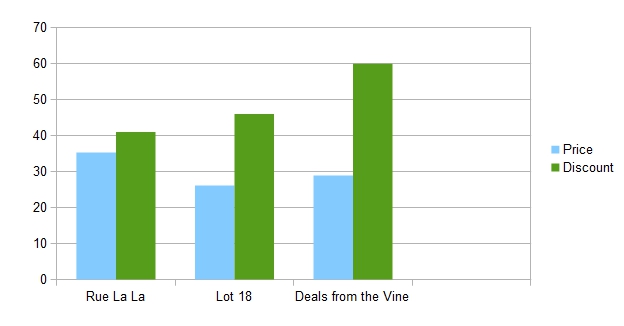 Beginning in October 2010, Deals from the Vine offered its members 28 different “deals.” My purchases in particular reflected an overall 60 percent discount from winery direct prices. While hailed as a success, it is currently on hiatus, promising a new site independent of Facebook. In a letter to members, Mabray writes,
Beginning in October 2010, Deals from the Vine offered its members 28 different “deals.” My purchases in particular reflected an overall 60 percent discount from winery direct prices. While hailed as a success, it is currently on hiatus, promising a new site independent of Facebook. In a letter to members, Mabray writes,
Due to the limitations of Facebook groups, we will be enhancing this program by launching a true site outside of Facebook that is more interactive and will help us better serve you and our wineries for no fees to either party. When we launch the new site we will be reflecting all deals from the site in this group. We do hope you will migrate with us to the new site which will be full of bells and whistles and will strive to find the best deals of wines for all of you and try all kinds of wackiness to help you connect directly with wineries.
It is the interaction, in addition to the cash, that wineries find particularly valuable. “They put bottles of your wine into the hands of many new consumers. I’ve had many visitors to the tasting room who purchased our wine for the first time at a Flash sale, ” says another Napa Valley winery owner.
Of the sites I visit, one seems to be generating quite a buzz since its inception.

Lot 18
The brainchild of the Philip James, founder of the wickedly popular Snooth.com, and technology entrepreneur Kevin Fortuna, Lot 18 is based in New York City with a “procurement” team based in California wine country. Unlike Cinderella Wine, Lot 18 holds no wine sales license, but acts as promoter and advertiser for the winery, who then ships the orders to the customer. It does charge a flat shipping (or processing) fee of $9.95 per bottle, but offers free shipping on multiple orders of a single wine (4-6 bottles).
Wines & Vines’ tracking of all Lot 18 offerings in December 2010 shows an average discount of 39 percent. Of the 18 bottles I have purchased since January 2011, average price per bottle for me has been about $28, reflecting an average discount off retail of 46 percent.
Wineries commenting reported favorable experiences with Lot 18, which stood out positively when compared to some of the other Flash sale sites. This was particularly true for smaller production, artisan wine companies.
“From the perspective of a boutique winery we don’t see a benefit in working with the majority of Flash sale sites because their pricing model is not attractive to us and we would lose money on the proposition,” says John Ogden, who manages marketing, sales, and business operations for Olson Ogden Wines in the Russian River Valley of Sonoma County. “We chose to work with Lot 18 because the way the wine is positioned on the website is representative of our luxury brand, it’s great for new customer acquisition, and their business model allowed us to sell our wine at a profit.”
Another Sonoma County winery sales manager, who prefers to speak anonymously, also reports positive results. Recommended to him by a local sommelier, he says Lot 18 offers a higher level of competency than other sites he used, and that the deal was done in just a few weeks. “We were 40 cases from being sold out and wanted to move on to the next vintage,” he says. “They were very easy to work with.”
While their agreement with Lot 18 disallows wineries contact with buyers after the sale, absent a new contact directly from the consumer, wineries say it achieves another goal: introducing them to new, potentially repeat customers.
“We are prohibited from contacting the customer directly after the sale. However, this is not an issue for us because we’ve found that customers who buy Olson Ogden Wines from Lot 18 are actively signing up for our mailing list,” says Ogden. While I purchased Olson Ogden Syrahs and other wines I had already tried as samples, Lot 18 did introduce me to some other wineries whose products I’ve since purchased at my local retailer.
The aforementioned Napa Valley sales manager says one key element of this discussion is how public or how private the offer is made by the Flash site.”To a producer like us, this has more bearing than the price,” says the manager. “We believe that sites that cater to just their members in a private manner and can prove to us that their clientele has the profile we are looking for are a valid sales channel because it allows our wine to reach customers that would be otherwise very difficult for us to identify. In some specific cases, the low price we received from the Flash site is a cost well worth paying.”
Twisted Oaks’ Stai agrees. “I feel that the real attraction of a Flash site is new customer acquisition,” he says. “The best sites give you both a fair return on the product and give you the chance to convert their customer to your customer.”
Flash sites help move inventory as well as introduce potential new customers to the winery brand. But are they all fair? Wineries weighed in.
“There are some Flash sites—I won’t name names—that I don’t personally consider fair,” says Stai. He indicates some sites that require wineries to market the Flash site to its own mailing list. “I don’t feel that my customers and fans expected that when they signed up with me.”
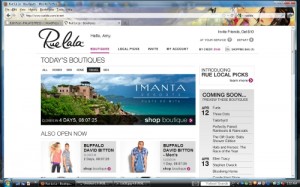
Now Selling Wine: Rue La La
Sites like Rue La La focus primarily on women’s fashion, but also include sales on menswear, home furnishings, and have recently added travel to their bevy of offerings. While billed as a member-only site, Rue La La allows current members to invite others, offering $10 of credit per referral after the new member’s first purchase. They offer excellent and prompt customer service to their members with only an occasional hiccup in the buying process. Rue La La began offering Flash deals on wine in late 2009. Discounts range from 30 to 50 percent off published suggested retail prices for bundled deals of two or more bottles up to mixed cases. Wine is shipped directly from the winery or winery fulfillment house, and customers are not charged until the wine actually ships.
As a consumer, I have purchased 24 bottles through Rue La La since November 2009, with an average price of $33 per bottle. While in the beginning I purchased wines with which I was unacquainted, I began watching for familiar names in order to augment my cellar with wines I had already tasted and knew I liked.
In one particular instance, my Rue La La purchase of three bottles turned into a shipment of an entire mixed case, after I had received a notice first that the winery could not ship to my state, and then an apology saying my three bottles were on their way. Luckily my credit card was charged only for the three-bottle order, but I felt obligated to contact the winery to remedy the over shipment—not so much because I’m an overly honest goody-two-shoes, but that I didn’t want to be on the other side when Karma came to collect.
Rue La La charges a flat fee of $9.95 for all orders placed in a single day, so if one were to combine a wine order with clothing or kitchen appliances, it is safe to assume that the cost of the shipping is covered by the winery as a deduction from total sales.
From the winery perspective, those commenting were less impressed with Rue La La. The Sonoma County winery sales manager says the transaction was arduous and convoluted, and Rue La La created some pretty big expectations and then did not deliver. While wines I purchased from this winery offered outstanding quality, some others on Rue La La have been disappointingly past their prime.
Another Napa Valley winery owner sees this as a by-product of market saturation. He said he is backing away from the Flash site market because in his opinion, they have hit their high water mark. “There are too many of them now so the general quality level of the wines being offered is going down. Some days they offer wines I haven’t heard of or are not very interesting. The excess inventory they live on is drying out at quality wineries.”
Perhaps, but one particular Flash site with monster traffic stats is keeping some wineries happy.
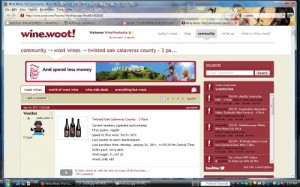
wine.woot!
Jeff Stai calls wine.woot! the “big daddy of them all.” With monster traffic stats in December (555,555 pageviews reported) wine.woot! also offers wineries an opportunity to interact with would-be customers, and Stai reports a great experience:
Wine.woot! has online forums set up so that the winery can interact with their potential customers during the sale. This is actually quite powerful and definitely drives sales for the winery that best takes advantage of it—there is your ROI on social media. And it does not hurt that their overall customer base is HUGE.
Stai reports a quirk of wine.woot!, unlike most if not all other wine Flash sites, is that at the end of the sale the final stats are displayed. He shared the stats of Twisted Oak’s most recent deal, which show a number of aspects of the Flash event including number of three-packs sold, percentage of sales per hour, and where the sales come from. There is a description of the winery as well as five pages of discussion during the event.
“So you can see that we sold 683 three-packs, which is roughly three pallets of wine,” says Stai. “I’ll sell three pallets of wine all day at near-FOB!”
Stai says wine.woot! also allows the winery to add any marketing information to the shipped box, including a follow-on deal. Stai says he offered a six-pack of Twisted Oak *%#&@! red Rhône-style MSG blend exclusive to the wine.woot! purchasers, which has generated dozens of additional sales.
Getting Around Direct-to-Consumer Shipping Restrictions
Flash sites can also offer an end-around to consumers who live in states prohibiting retail direct shipping from online sites like Ferry Plaza Wine Merchant, JJ Buckley, and Cinderella Wine. While some state laws ban direct shipments entirely, others allow shipments from wineries as long as those wineries have the proper state permits. Flash sites operate in the gray area, promoting a number of wines from different wineries, much like a retail website. But because the wine ordered on these sites is shipped directly from the winery or a winery fulfillment company, consumers in those states with only a ban on retail-to-consumer shipping can still take advantage of “sales” not offered at the winery or on the winery website.
To keep everything on the up-and-up, some Flash sites like Rue La La do not charge the the buyer’s credit card until the wine ships from the winery. How is this legal? Technically the Flash site is simply arranging shipping for the buyer, who takes title to the wine from the winery, a loophole often used by retailers who operate in states like California and Washington.
For the consumer, it is caveat emptor. Know your state’s shipping laws. Look for reputable sites and get referrals from friends when making big purchases on new wines. Leave the unknown for the smaller buys.
The Future of Wine Flash Sites; Lessons Learned
While some of the wineries see Flash sites as purely a byproduct of a bad economy, others think they are here to stay.
“I see a chicken-and-egg question in whether deal-a-day operations are simply taking advantage of the zeitgeist, or have created a new demographic of customer,” says Westwood Winery’s John M. Kelly. “Whether these sites are a cause or a symptom, it seems that the typical deal-a-day customer is more focused on the deal than on the wine itself. There is a very low conversion rate to repeat retail customer for us as a winery. I imagine there is a fairly high conversion rate to repeat customer for the sites themselves.”
Kelly advises wineries thinking about turning to Flash sites to do their homework and not over commit. The Sonoma County winery sale manager sees Flash sites as just one more discount strategy for wineries. “The best ones will thrive and the lesser ones will go away.” The Napa Valley winery owner was less optimistic.
“The excess inventory they live on is drying out at quality wineries,” he says. “During the worst of the recession there was little attention paid to discounting as everyone and everybody was doing it. Now the economy is getter stronger and inventories are lower a winery needs to be more concerned with maintaining their price points.”
As the economy improves, he says, the traditional distribution channels are returning to their former strength and will pull more quality away from the Flash sale sites.
“I think in 2012 you’ll start to see them disappear as quickly as they appeared, but the best few will survive, as is normal.”
 Amy Corron Power is a licensed e-Discovery attorney with a background in marketing and public relations. A writer and photographer for Another Wine Blog, and regular TasteLive! panelist, she has also covered college football and basketball for a number of sports publications including ESPN.com. A member of the Society of Wine Educators and a self-avowed political junkie, she occasionally contributes to the nationally syndicated blog, MOMocrats™.
Amy Corron Power is a licensed e-Discovery attorney with a background in marketing and public relations. A writer and photographer for Another Wine Blog, and regular TasteLive! panelist, she has also covered college football and basketball for a number of sports publications including ESPN.com. A member of the Society of Wine Educators and a self-avowed political junkie, she occasionally contributes to the nationally syndicated blog, MOMocrats™.


